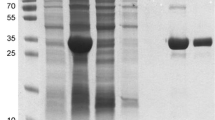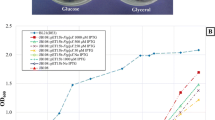Abstract
A high-virulence clone of serotype IIIStreptoccus agalactiae causing invasive neonatal disease has recently been identified by multilocus enzyme electrophoresis and can be further distinguished by its inability to grow at 40°C in a chemically defined medium. The basis for the unusual growth inhibition at 40°C was examined in the present study and shown to be owing to a temperature-sensitive fructose-1,6-bisphosphate aldolase (fba). Crude enzyme preparations (75% saturated ammonium sulfate precipitates) of fba obtained from a high-virulence clone demonstrated a 75% reduction in aldolase activity when preincubated at 40°C for 30 min compared with 37°C. In contrast, fba from a serotype III isolate obtained from an asymptomatically colonized infant demonstrated <10% decrease in activity at 40°C. Comparison of another enzyme, lactate dehydrogenase (ldh), from both organisms indicated no loss in activity at 40°C compared with 37°C. Glyceraldehyde-3-phosphate, one of the end-products of fba activity, relieved growth inhibition at 40°C.
Similar content being viewed by others
Literature Cited
Chen PS, Torihara TY, Warner H (1956) Microdetermination of phosphorous. Anal Chem 28:1756–1758
Durham DL, Mattingly SJ, Doran TI, Milligan TW, Straus DC (1981) Correlation between the production of extracellular substances by type III group B streptococcal strains and virulence in a mouse model. Infect Immun 34:448–454
Loewus FA (1952) Improvement in anthrone method for determination of carbohydrates. Anal Chem 24:219
Mattingly SJ, Maurer JJ, Eskew EK, Cox F (1990) Identification of a high-virulence clone of serotype IIIStreptococcus agalactiae by growth characteristics at 40°C. J Clin Microbiol 28:1676–1677
Maurer JJ, Mattingly SJ (1988) In vitro method to differentiate isolates ofStreptococcus agalactiae from symptomatic and asymptomatic patients. J Clin Microbiol 26:686–691
Milligan TW, Baker CJ, Straus DC, Mattingly SJ (1978a) Association of elevated levels of extracellular neuraminidase with clinical isolates of type III group B streptococci. Infect Immun 21:738–746
Milligan TW, Doran TI, Straus DC, Mattingly SJ (1978b) Growth and amino acid requirements of various strains of group B streptococci. J Clin Microbiol 7:28–33
Moore S, Stein WH (1954) A modified ninhydrin reagent for the photometric determination of amino acids and related compounds. J Biol Chem 211:907–913
Musser JM, Mattingly SJ, Quentin R, Goudeau A, Selander RK (1989) Identification of a high-virulence clone of type IIIStreptococcus agalactiae (group BStreptococcus) causing invasive neonatal disease. Proc Natl Acad Sci USA 86:4731–4735
Nealon TJ, Mattingly SJ (1983) Association of elevated levels of cellular lipoteichoic acid of group B streptococci with human neonatal disease. Infect Immun 39:1243–1251
Yeung MK, Mattingly SJ (1984) Biosynthetic capacity for typespecific antigen synthesis determines the virulence of serotype III strains of group B streptococci. Infect Immun 44:217–221
Author information
Authors and Affiliations
Rights and permissions
About this article
Cite this article
Mattingly, S.J., Eskew, E.K. Temperature sensitivity of fructose-1,6-biphosphate aldolase accounts for the inability of the high-virulence clone ofStreptococcus agalactiae to grow at 40°C. Current Microbiology 26, 147–150 (1993). https://doi.org/10.1007/BF01577369
Issue Date:
DOI: https://doi.org/10.1007/BF01577369




